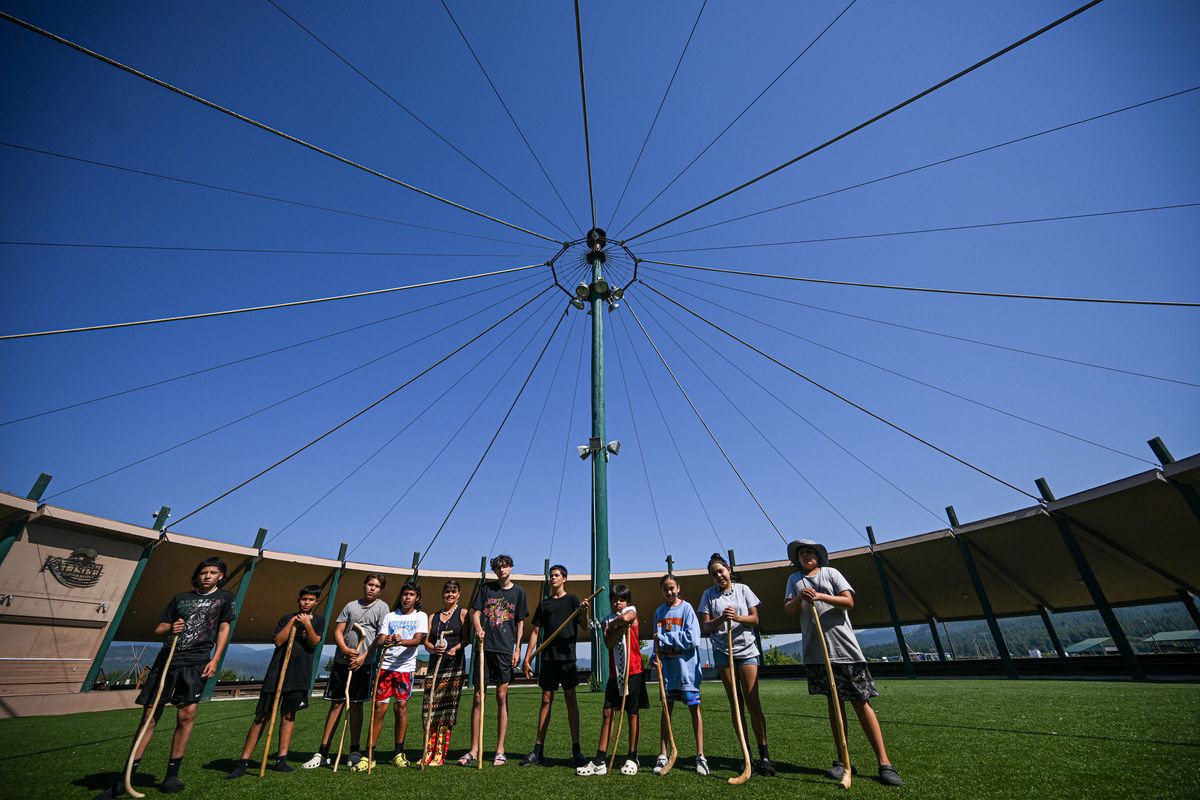‘Not forgotten’: Culture camp teaches next generation of Kalispels traditional crafts

CUSICK, Wash. – The light scent of campfire wafted through the Kalispel Powwow Grounds along the east bank of the Pend Oreille River last week. Although summer camp was taking place, this wasn’t an ordinary campfire. It was an earth oven buried underground baking camas, an ancient staple of the Kalispel Tribe.
Children of the tribe who attended the Kalispel Culture Camp were assigned to collect camas bulbs the size and shape of an acorn from nearby fields using a pole tool to dig them out of the ground. It’s hard work, because the ground is dry and tough.
Meanwhile, adult counselors prepared the oven. First, they dug a square hole 3 feet deep, placed porous volcanic rock on the bottom and built a fire on top, which they let burn a few hours until the rocks got hot.
They took the fire off of the rocks and layered alder wood, cedar bark, skunk cabbage, black moss and, finally, camas – then, another layer of everything in reverse order: black moss on top of the camas, then skunk cabbage and so on. The skunk cabbage acts like foil, protecting the edible layers of camas and black moss.
Finally, they filled the dirt back in the hole and built another fire on top of the ground so heat from above and the rocks below bake the concoction.
Adults took shifts watching the fire, even overnight, for 72 hours.
This is the same method that has been used for millennia.
Evidence of these ovens from 6,000 years ago was discovered at an archaeology site last year about 20 miles up the river near Newport, Washington, where the tribe is building new housing.
After three days underground, the camas is ready to enjoy. With a soft, starchy texture, it tastes like sweet potato and date.
Once it is cool, they slice the black moss into cakes or mash it together in a pudding. Adding sugar is optional.
Camas is a symbolic food for the tribe. Historically, the tribe didn’t fish salmon directly, but used camas to trade with other tribes, cultural specialist and camp planner Wilma Sherwood said.
Today, several of the tribes’ enterprises are named for the plant, such as the Camas Center, a health and wellness facility on the reservation.
“It’s one of our oldest traditional foods, and we all still know how to cook it,” Sherwood said. “Not a lot of people eat it nowadays. It got to a point where we only make it on special occasions.”
The camp helps keep this and other traditions alive, “so it is remembered, not forgotten.”
Throughout the week, kids learned crafts like beading, making necklaces and baby moccasins; they also played folk games.
Kiara Umbarger, 11, most enjoyed making a God’s eye ornament of yarn wrapped in a diamond shape over a wood cross.
“It’s easy, fun to make,” she said. “You can do different designs if you want.”
Another confection is “sxusem,” a creamy treat made from foamberries. First, they soak a handful of the tiny, dried, blood-orange-colored berries in water, then whisk until it foams and eventually transforms into sweet fluff the texture of whipped cream. Again, extra sugar is a modern option.
“I see culture camp as a gathering place to reclaim knowledge and instill in our youth our cultural practices,” said Kalispel archivist Annette Pierre, who taught weaving at the camp.
Passing on that knowledge is a way to honor each other and to honor ancestors, she said.
“Our story is one of humility and resilience,” Pierre said. “Part of being Kalispel is taking care of each other.”
Gabriel Garcia, 11, enjoyed plain summer fun with friends: water balloon fights and swimming in the river and lakes.
“We swim every day!” he said.
Different activities bring out natural talents of each kid, camp supervisor Yolanda Larion said. They might not be interested in everything, and that’s OK.
Team-building activities build trust and strength through community.
Community is important for the tribe, as its members have struggled through addictions, mental health and family issues, Larion said.
“We try to find ways to help people in our community heal,” she said.
A few generations ago, the tribe’s culture and language were nearly lost through the boarding school era, when Native people were punished for speaking their language and restricted from practicing their culture. Men who fought in the world wars and Vietnam came back with more trauma, and alcoholism took another great toll on the culture, Larion said.
Because it happened over a long time, those generations didn’t realize what was being lost with their children.
Larion and Sherwood are becoming the elders now, and they hope today’s children take an interest in these cultural skills.
“When we’re gone, you guys are going to be the ones passing it down,” they tell the campers. “So don’t let it die out.”